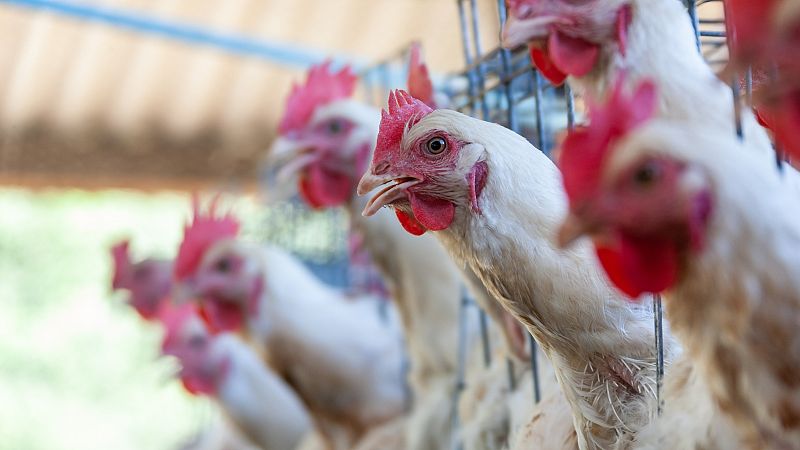
As bird flu spreads across Europe and jumps to more animal species, health experts warn that gaps in surveillance and preparedness could leave the region vulnerable to future threats to human health.
Avian influenza has been spreading at elevated levels worldwide over the past five years, including in wild and farm birds in the European Union.
Hungary has reported the most outbreaks since last autumn, followed by Germany, the Netherlands, and poultry giant Poland.
But in recent years, bird flu has also spread to mink, cats, a captive bear, and other mammals, raising the risk that the virus will eventually reach people.
Tens of millions of birds and other animals have been culled to keep that from happening, but gaps in surveillance systems increase the likelihood that the virus could circulate undetected and become harder to control.
Since 2003, about half of the nearly 1,000 people infected with H5N1 bird flu globally have died.
Now, EU health officials say public health risks remain low, and there is no evidence of human-to-human transmission.
But preparations are already underway: the European Commission recently clinched a deal to secure more than 27 million influenza vaccines in case of a pandemic.
Monitoring bird flu
Officials are also eyeing an outbreak among dairy cows in the United States – which has spread to people, infecting 70 and killing one – as a reminder to monitor animals beyond birds and mink, which are more prone to infection.
"It's not a time to really sit back and relax and say, 'oh well, this is just business as usual,'" Marion Koopmans, who directs the centre of excellence at the Global Virus Network and leads the viroscience department at Erasmus Medical Centre in the Netherlands, told Euronews Health.
"It has really changed compared with just a few years ago," she added. "It’s not a good situation to have".
EU countries actively monitor wild birds and poultry for avian influenza. When they find infections, they must take steps to stamp out the virus, such as culling birds and imposing farm restrictions.
Now, with the US cattle outbreak in mind, the European Food Safety Authority (EFSA) is working with member states to boost surveillance in cows and other mammals, according to Alessandro Broglia, one of the agency’s senior scientists.
"There is a kind of reactivity and enhanced preparedness in Europe, also to prevent the infection in cattle and other farm animals," Broglia told Euronews Health.
Vaccination is also playing a bigger role. In 2023, France began immunising birds, a move it says has helped its poultry industry recover after outbreaks ravaged its farms and annihilated tens of millions of birds.
And last summer, Finland became the first EU country to offer bird flu vaccines to people, doling out jabs to 10,000 workers who were at higher risk of infection.
Even so, EU audits have identified gaps in these systems that could be just large enough for the virus to slip through undetected.
Weaknesses in prevention
Over the past two years, they have found delays in setting up restriction zones to prevent the virus from spreading in Poland; "limited effectiveness" in Portugal's early warning system for poultry infections; shortcomings in investigations of suspected cases in Spain; and poor risk assessment, a lack of surveillance, and inadequately trained staff in Hungary that constitute "crucial weaknesses" that have not been rectified since the country was last audited in 2020.
A Commission spokesperson told Euronews Health that Spain and Portugal have taken steps to fix these issues, but that it is “seeking additional commitments” from Hungary and Poland, which suspended poultry exports last month due to outbreaks.
Alexandre Fediaevsky, acting head of preparedness and resilience at the World Organisation for Animal Health (WOAH), said that “in all countries, Europe included, there is still some room for improving biosecurity and early warning systems”.
But there has been some resistance from some farmers and poultry industry groups, who fear new rules and restrictions could threaten their businesses.
"We need to have some strategic dialogue with the industry," Fediaevsky told Euronews Health, but "it will be a long process to really transform the production systems".
The EU and the US are not the only places grappling with elevated bird flu risks. Last week, the Commission said poultry and meat imports from Brazil had been halted after the country confirmed its first bird flu outbreak on a farm.
For now, bird flu appears to pose a greater risk to the EU’s food supply than to public health. However, Koopmans warned that without stronger measures to curb the virus’ spread among birds, the bloc could be caught off guard if human infections begin to emerge.
"Let's also not become negligent," she said, "because this is how these viruses eventually trigger pandemics".







